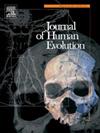New insights into the Neanderthal pelvis morphology based on a partial os coxae from El Sidrón (Asturias, Spain)
IF 3.1
1区 地球科学
Q1 ANTHROPOLOGY
引用次数: 0
Abstract
The Neanderthal pelvis exhibits distinctive features compared to modern humans, including wider and more flared iliac blades, a more anteriorly positioned sacrum, and a longer and thinner, outwardly oriented pubic bone. Each new addition to the pelvic fossil record is significant for enhancing our understanding of Neanderthal morphology and variation. Here, we present SD-1663, the most complete adult os coxae fragment recovered from the El Sidrón site in Asturias (Spain), dated to approximately 49 ka. We carried out a detailed description and quantitative analysis of SD-1663 within a comparative framework that includes other notable pelvic fossil specimens. Utilizing traditional and three-dimensional morphometric techniques, we assessed the morphological characteristics of SD-1663 focusing on dimensions and anatomical landmarks that distinguish Neanderthal pelves from those of other hominins. The analyses reveal that SD-1663 was a young adult male with features and size that clustered with other Neanderthals in our comparative sample. However, SD-1663 also shares significant morphological affinities with earlier Pleistocene Homo specimens such as KNM-ER 3228 (Homo erectus), suggesting a broader range of pelvic variation within Neanderthals than previously recognized. This discovery contributes to expanding the Neanderthal range of anatomical diversity, indicating that the Neanderthal pelvis may have been more variable than the current fossil record suggests. It also underscores the importance of continued excavation and analysis of Neanderthal remains to fully comprehend the scope of their anatomical adaptations and evolutionary history. SD-1663 thus represents a valuable addition to the fossil record, offering new perspectives on Neanderthal pelvis morphology and its variation.
基于El Sidrón(西班牙阿斯图里亚斯)部分os coae对尼安德特人骨盆形态的新见解
与现代人相比,尼安德特人的骨盆表现出独特的特征,包括更宽、更宽的髂骨,更靠前的骶骨,更长、更薄、向外的耻骨。骨盆化石记录的每一个新发现都对增强我们对尼安德特人形态和变异的理解具有重要意义。在这里,我们展示了SD-1663,这是在阿斯图里亚斯(西班牙)的El Sidrón遗址中发现的最完整的成年os cocoae碎片,可追溯到大约49年前。我们在一个比较框架内对SD-1663进行了详细的描述和定量分析,其中包括其他著名的骨盆化石标本。利用传统和三维形态测量技术,我们评估了SD-1663的形态特征,重点是将尼安德特人与其他人类区分开来的尺寸和解剖标志。分析显示,SD-1663是一名年轻的成年男性,其特征和体型与我们比较样本中的其他尼安德特人相似。然而,SD-1663也与早期更新世人标本(如KNM-ER 3228(直立人))具有显著的形态学相似性,这表明尼安德特人的骨盆变异范围比之前认识到的要大。这一发现有助于扩大尼安德特人解剖学多样性的范围,表明尼安德特人的骨盆可能比目前的化石记录显示的更加多样化。这也强调了继续挖掘和分析尼安德特人遗骸的重要性,以充分了解他们的解剖适应和进化历史的范围。因此,SD-1663代表了对化石记录的宝贵补充,为尼安德特人骨盆形态及其变异提供了新的视角。
本文章由计算机程序翻译,如有差异,请以英文原文为准。
求助全文
约1分钟内获得全文
求助全文
来源期刊

Journal of Human Evolution
生物-进化生物学
CiteScore
6.30
自引率
15.60%
发文量
104
审稿时长
3 months
期刊介绍:
The Journal of Human Evolution concentrates on publishing the highest quality papers covering all aspects of human evolution. The central focus is aimed jointly at paleoanthropological work, covering human and primate fossils, and at comparative studies of living species, including both morphological and molecular evidence. These include descriptions of new discoveries, interpretative analyses of new and previously described material, and assessments of the phylogeny and paleobiology of primate species. Submissions should address issues and questions of broad interest in paleoanthropology.
 求助内容:
求助内容: 应助结果提醒方式:
应助结果提醒方式:


